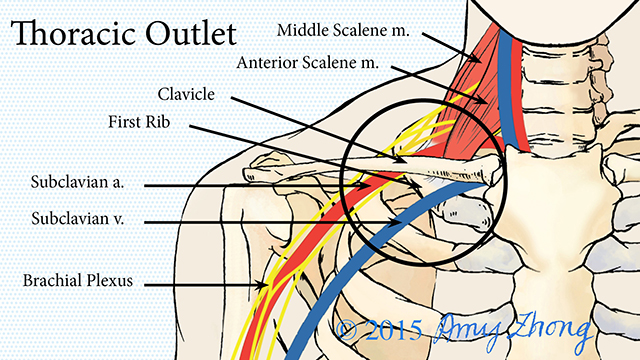
What is Thoracic Outlet Syndrome?
I’ve heard the same things everybody else has.
Markelle Fultz has apparently been to something like 10 specialists in an effort to discover what’s wrong with his shoulder. Only yesterday did we finally get a diagnosis for the shoulder issue that ails him, a diagnosis of “Thoracic Outlet Syndrome.”
TOS, in simple terms, is a compression of the Thoracic Outlet located in the area between the lower neck and upper chest. That “outlet” consists of the Brachial Plexus and an artery and vein located just below the clavicle.
Here’s a handy diagram, courtesy of Hopkins Medicine, that shows the area in question:
The circled area is the Thoracic Outlet, which contains the Plexus (yellow), the subclavian artery (red), and the subclavian vein (blue). The Brachial Plexus is basically a network of nerves that extends from your spinal cord through your neck and over the ribcage into your armpit. While nerves are present in this area, TOS isn’t considered a “nerve issue,” it’s categorized as a group of disorders and not one specific thing.
There is, however, a bit of discrepancy in the language used by the Sixers and Markelle’s agent, Raymond Brothers, because in the press release the team says he has “Thoracic Outlet Syndrome” while Brothers told Adrian Wojnarowski that Markelle has “Neurogenic Thoracic Outlet Syndrome,” which would suggest that the compression is on the nerve bundle and not the veins. A “vascular” TOS would be the compression of those veins instead, which is easier to diagnose than the neurogenic variety because the patient would have altered pulsations or more identifiable blood vessel issues. The neurogenic version of TOS is said to be more common but harder to diagnose.
People with TOS will suffer from their collarbone, chest muscle, or neck muscle pushing against one or more of the aforementioned vessels or nerves, which results in pain in the neck and shoulders or a numbness and weakness that shoots down to the hand and fingers. The sensations are inconsistent and TOS presents itself in a somewhat erratic way.
You may remember The Athletic report that came out about two weeks ago, a combo effort from Jared Weiss, Derek Bodner, and Sam Amick. In that write up, it’s mentioned that Fultz was also dealing with a wrist injury, and this passage jumps out at me specifically:
In addition to a previously diagnosed right shoulder injury that continues to impact him, Fultz has been playing with an apparent injury in his right wrist area that has adversely affected his ability to shoot, league sources told The Athletic. The issue has led to periodic difficulties holding on to the ball during his shot. Specialists have been working with Fultz to figure out how they can strengthen the wrist area to remedy the injury.
….
The wrist and shoulder injuries’ impact varies; some days they badly hinder him, other days they do not, causing an erratic pattern in which his shot appears to be working one game and is off the next. As he tries to work through and compensate for the injury, it has at times resulted in a case of the ‘yips,’ especially when shooting free throws.
That would mesh with the symptoms of TOS, the idea that if Markelle was feeling numbness or tingling in his hands via the impacted nerves or veins, that he would have trouble gripping a ball or making consistent shooting motions due to wonky compression patterns. I don’t know how that manifests itself when Markelle goes up to block a shot or dunk the basketball with one hand, but those motions do not feature the same muscle usage as shooting a basketball with two hands.
Over at Philly.com, Sarah Todd talked to California pain management specialist Medhat Mikhael, and I found this passage interesting regarding the difficulty and length that it takes to correctly diagnose TOS:
“…a lot of the time there are physicians that miss the diagnosis. I’ve seen patients treated in so many ways and seen patients that ended up with a neck surgery or fusion surgery because they thought something else was causing the patient’s symptoms and they went ahead an operated and then the patient continued to have the symptoms. A lot of times patients will rush into treatment thinking that they know the cause, thinking that’s it’s coming from a certain point, but it is not.”
TOS is categorized as a diagnosis of exclusion, which means that you’ve basically ruled out everything else to reach your conclusion. A good example of a similar diagnosis is Irritable Bowel Syndrome, which can involve a number of different signs and symptoms. Maybe you get a colonoscopy or an upper GI endoscopy, and the doctor doesn’t find anything. You’re in the clear. No diverticulitis, no colon cancer, nothing like that. They just circle back to an IBS diagnosis because they don’t see anything conclusive in the testing. You’ve basically just gone through a process of elimination, and it can take a long time to get there.
At this point, I’m more interested in the cause of Markelle’s problem, which we still don’t have an explanation for. We don’t know how this happened. Did it stem from the scapular muscle imbalance? If so, where did the scapular muscle imbalance come from? We’ve asked Bryan Colangelo, Brett Brown, and Elton Brand about the genesis of the injury, which they claim they do not know. We asked Markelle about it last year, and he responded with total silence while staring into the abyss. The theory that he hurt himself in a bike accident was squashed publicly by Raymond Brothers. Do you believe Brothers or not? The whole thing is bizarre.
According to the Mayo Clinic, these are some possible causes of TOS:
- Anatomical defects. Inherited defects that are present at birth (congenital) may include an extra rib located above the first rib (cervical rib) or an abnormally tight fibrous band connecting your spine to your rib.
- Poor posture. Drooping your shoulders or holding your head in a forward position can cause compression in the thoracic outlet area.
- Trauma. A traumatic event, such as a car accident, can cause internal changes that then compress the nerves in the thoracic outlet. The onset of symptoms related to a traumatic accident often is delayed.
- Repetitive activity. Doing the same thing repeatedly can, over time, wear on your body’s tissue. You may notice symptoms of thoracic outlet syndrome if your job requires you to repeat a movement continuously, such as typing on a computer, working on an assembly line or lifting things above your head, as you would if you were stocking shelves. Athletes, such as baseball pitchers and swimmers, also can develop thoracic outlet syndrome from years of repetitive movements.
- Pressure on your joints. Obesity can put an undue amount of stress on your joints, as can carrying around an oversized bag or backpack.
I’d imagine any early medical scan would have revealed an anatomical defect. Markelle is certainly not obese and I don’t think he was lugging around oversized bags at Washington or in high school.
Trauma would make the most sense, but you would leave the door open for “repetitive activity” wearing on the body. If Fultz took 40 bazillion shots this summer with Drew Hanlen, did that uber-training ultimately turn out to be counterproductive to his health?
I’ve said before that we have Fultz, Brown, and Brand on record within the past 30 days, each saying that Markelle was fine. He himself never complained about shoulder issues this year, and if he said something internally, like “coach I don’t feel right,” then the Sixers obviously complied with that because he’s seen multiple different specialists over the past however many weeks and months. That’s the whole point of allowing second and third and fourth opinions via the collective bargaining agreement, so that NBA teams can’t just say, “you feel fine, get your ass out on the court.”
I also don’t really buy the fact that the Sixers medical staff is completely inept. Athletic team doctors are generally specialized in, well, athletic injuries. They’re good with knees and elbows and backs, common issues basketball players suffer from. How much does Dr. Danny Medina really know about Zhaire Smith’s sesame seed allergy? Probably jack shit, so they outsource the medical analysis to an allergy specialist and will generally send a team doctor along for any visits. It’s not like they just say, “okay, we’re gonna send you to a shoulder specialist, let us know how it goes!” They are a part of the process from start to finish.
Likewise, when you go to your primary care physician for a throat problem, he or she will likely send you to an ENT specialist who knows what they’re talking about. The world of athletic medicine isn’t entirely different from what you and I experience.
Again, what I’m interested in is this:
“Markelle, what do you think is the cause of this Thoracic Outlet Syndrome?”
That’s really the most important question moving forward. I’m skeptical that three to six weeks of physical therapy will fix all of his problems, but I’m not cheering against the kid, not at all. Something about all of this just feels “incomplete” to me.






